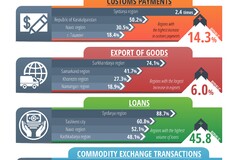Based on real-time data provided by the Central Bank, the Tax Committee, the Customs Committee, and the Uzbek Republican Commodity Exchange, the Center for Economic Research and Reforms (CERR) conducts monthly monitoring and comprehensive analysis of business activity across all regions of Uzbekistan.
According to the latest data, tax revenues in May demonstrated a solid upward trend, increasing by 18% compared to the same period last year. A breakdown of regional tax revenues revealed several positive developments.
Significant increases were recorded in Tashkent region (up 52.8%), Syrdarya (37.9%), Namangan (37.5%), Andijan (36.7%), Bukhara (34.7%), Fergana (31.8%), and the capital city (45.1%).
The increase in tax revenues reflects the expansion of goods and services production, rising business income, and improved employment.
For instance, personal income tax receipts rose by 17.1%, directly indicating growth in employment, rising wages, and improved purchasing power.
Property tax revenues increased by 18.7%, suggesting continued stability in the real estate market and growth in asset values — a sign of strong investor interest in the sector.
Land tax collections rose by 17.2%, driven by the integration of new land plots into economic circulation, pointing to the active development of agriculture, industry, and logistics.
The foreign economic sector also showed strong momentum, with customs duties increasing by 14.3%, confirming the growth of international trade volumes, rising export capacity, and deeper integration into global economic processes.
Particularly high customs revenue growth was observed in Syrdarya (up 138.4%) and the Republic of Karakalpakstan (up 50.2%), with moderate yet stable growth in Navoi (30.5%), Tashkent (16.2%), Namangan (13.5%), and the city of Tashkent (18.4%).
The increase in customs revenues was driven by higher import volumes across several key categories, including equipment, metals, food products, chemicals, plastics and rubber, wood, paper, construction materials, tobacco products, and crop production.
Exports also continued to perform strongly in May, rising by 6% year-on-year. The most notable export growth was seen in Surkhandarya (74.1%), Samarkand (41.7%), Khorezm (27.3%), and Namangan (18.9%) regions.
In parallel, there was a significant increase in lending volumes — a key indicator of growing investment activity. The total volume of loans issued in May rose by 45.8% compared to the same period last year.
The most substantial increases in lending were recorded in Syrdarya (88.7%), Navoi (52.1%), Kashkadarya (48.1%), Namangan (46.4%), Surkhandarya (34.9%), and the city of Tashkent (60.8%).
The dynamic growth of the private sector is further supported by a significant rise in the number of newly registered businesses. Over 34,000 new enterprises were registered in May, reflecting a favorable business climate and the effective implementation of entrepreneurship support programs.
The largest numbers of new entities were registered in Tashkent region (3,405), Khorezm (2,909), Fergana (2,866), Samarkand (2,530), and the city of Tashkent (7,830).
In addition, commodity exchange activity also showed strong momentum. The total volume of transactions on the Uzbek Republican Commodity Exchange (UzEx) rose by 35.8% during the reporting period.
This growth in exchange turnover demonstrates that enterprises are increasingly turning to transparent and open procurement mechanisms to reduce costs and ensure supply stability. Notable increases in exchange activity were observed in Kashkadarya (83.4%), Jizzakh (62.6%), Syrdarya (60.5%), Surkhandarya (59.5%), and the Republic of Karakalpakstan (65.9%).
Sultonmurod Ozodov, CERR






















leave a comment